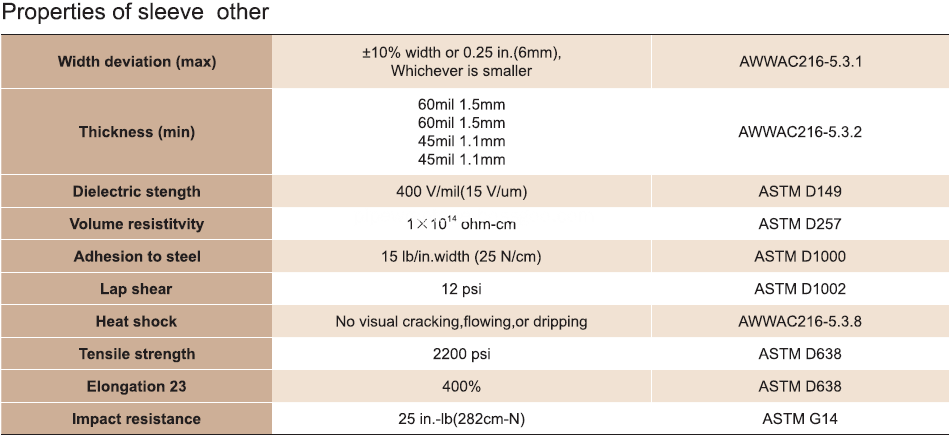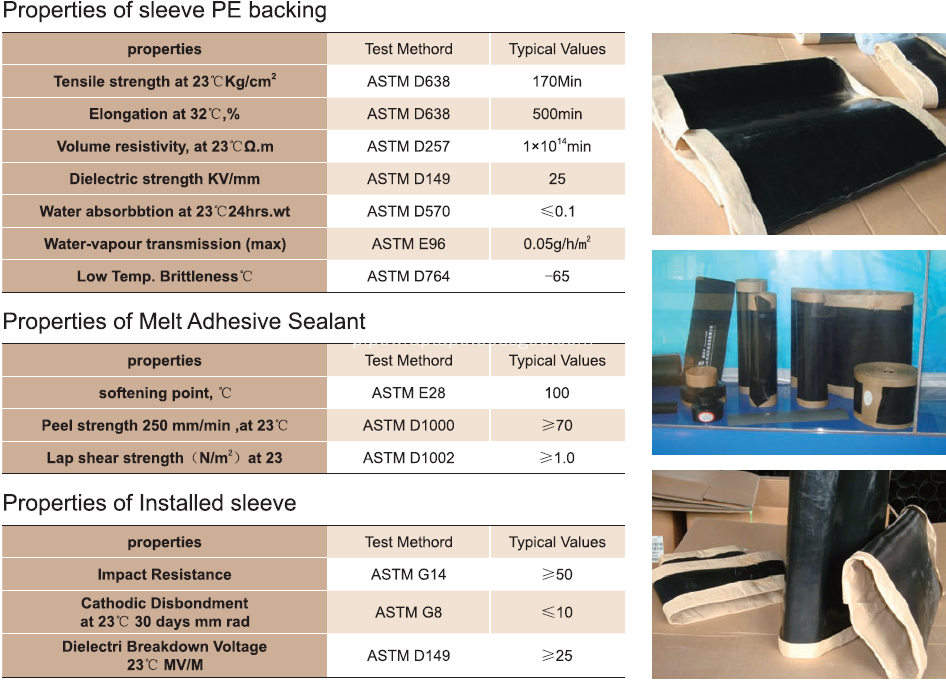I System description:
Heat Shrinkable Tape is designed to protect the weld joint of buried or exposed steel pipelines and insulated pipeline. This sleeves are manufactured from high quality cross linked polyethylene material. Hot melt adhesive provides excellent adhesion with the surface of steel pipeline, PE coating. Meanwhile it forms a continuous and firm anti-corrosive system with the surface of the pipeline.
The Polyethylene Heat shrinkable Tape needs no primer nor patch closure and reduces application time and labour costs.
â…¡ Structure
The specification of the tape consists of three layers,
Adhesive: butyl rubber based hot melt adhesive
Film backing: Radiation crosslinked polyethylene
Interleaf:Antiadhesive Film Treated with Silicone
â…¢ Features
After heating, formed corrosion protection seal
Strong backing provides outstanding waterproofing effect
High chemical resistance. resists impact, abrasion and ultraviolet light.
Excellent resistance against cathodic disbondment, dielectric breakdown.
Simple Application
â…£ Physical Properties
· Product Data Sheet Total Thickness:40mil, 50 mil,60 mil ,65 mils.
· Width:50,100,150,300,400,500,800 mm
· Length: 10 m
· Tensile Strength:35 N/cm
· Elongation:400%
· Adhesion Strength to pipe:30 N/cm
· Application temperature: -10 -60 ℃
· Temperature resistance:-50 ℃ - 80℃
· Shelf Life: 12 months
â…¤ Application
No Special skills, equipments, patch closure nor primer are needed. Its superior flexibility provides easy and reliable application for irregular configurations of fittings, bends and elbows and small diameter of straight pipes
Wrap spirally the tape over foreign matters-free and preheated surface, beginning at least 25~50mm (1~2 ) onto pipe coating. Wrap the tape with enough tension to obtain conformability and with minimum 50% of overlapping, while removing the release liner. Warm the end part of the tape and press down firmly. Using a torch, start at the edge of the tape and heat circumferentially around the coated pipe.
Finish off by heating over the entire tape vertically to ensure a uniform adhesion and by using a roller or gloved hands to remove wrinkle and air.
VI. Technical Datas
Hot Shrink Adhesive Tape, Heat Shrinkable Electrical Tape, Heat Shrinkable Wrap Tape, Shrinking Tape, Heat Applied Tape Coating System Jining Xunda Pipe Coating Materials Co.,Ltd , https://www.pipe-wrap.com



Human Decorin ELISA Kit
Human Decorin ELISA Kit For the quantitative in vitro determination of Human Decorin concentrations in serum - plasma - celiac fluid - tissue homogenate - body fluid FOR LABORATORY RESEARCH USE ONLY. NOT FOR USE IN DIAGNOSTIC PROCEDURES. This package insert must be read in its final before Using this product. ELISAENZYME LINKED IMMUNOSORBENT ASSAYINTENDED USE AND TEST PRINCIPLEThis Decorin ELISA kit is intended Laboratory for Research use only and is not for use in diagnostic or therapeutic procedures. The Stop Solution changes the color from blue to yellow and the intensity of the color is The measurement at the same time as the samples and allow the operator to produce a Standard curve of Optical Density versus Decorin concentration. The concentration of Decorin in the samples is then dete Rmined by comparing the OD of the samples to the standard curve. SAMPLE COLLECTION AND STORAGESSerum - Use a serum separator tube and allow samples to clot for 2 hours at room temperature or overnight at 4°C before centrifugation for 20 minutes at approximately 2000×g. Remove serum and assay immediately or aliquot and store samples at -20°C. Avoid repeated freeze-thaw cyclesPlasma - Collect plasma using heparin as an anticoagulant. Centrifuge samples for 30 minutes at 2000×g at 2-8°C within 30 minutes of collection. Store samples at -20°C. Avoiding freeze-thaw cycles.Cell culture supernates, tissue homogenate and other biological fluids - Remove particulates by centrifugation and assay immediately or aliquot and store samples at -20°C. : The samples shoule be centrifugated dequately and no hemolysis or granule was allowed.MATERIALS REQUIRED BUT NOT SUPPLIED1. 37 °C incubator2. Standard microplate reader capable of measuring absorbance At 450 nm3. Precision pipettes, disposable pipette tips and Absorbent paper4. Distilled or deionized waterREAGENTS PROVIDED All reagents provided are stored at 2-8°C. Refer to the expiration date on the label. Name 96 determinations 48 determinationsMicroelisa stripplate 12*8strips 12 *4stripsStandard(6 vial) 0.5ml/vial 0.5ml/vialSample diluent 6.0ml 3.0mlHRP-Conjugate reagent 10.0ml 5.0ml20X Wash solution 25ml 15mlChromogen Solution A 6.0ml 3.0mlChromogen Solution B 6.0ml 3.0mlStop Solution 6.0ml 3.0mlClosure plate membrane 2 2User manual 1 1Sealed bags 1 1Note: 1. Standard concentration was followed by: 200, 100, 50, 25, 12.5, 6.25 pg/mL.2. If samples generate values ​​higher than the highest standard, please dilute the samples with Sample Diluent And repeat the assay.PRECAUTIONS1. Do not substitute reagents from one kit lot to another. Standard, conjugate and microtiter plates are matched for optimal performance. Use only the reagents supplied by manufacturer. 2. Allow kit re Agents and materials to reach room temperature (20-25°C) before use. Do not use water baths to thaw samples or reagents. 3. Do not use kit components beyond their expiration date. 4. Use only deionized or distilled water to dilute 5. Do not remove microtiter plate from the storage bag until needed. Unused strips should be stored at 2-8°C in their pouch with the desiccant provided. 6. Use fresh disposable pipette tips for each transfer to avoid contamination. Disposable knuckle must be treated as potentially hazardous and capable of transmitting disease. Disposable knuckle must be during the assay procedure, since no known test method can offer complete assurance that products derived from Rat blood will not transmit infectious agents. Therefore, all blood derivatives should be considered potentially infectious and good applicant practices should be followed. 9. All samples should be disposed of in a manner that w 11. ill inactivate viruses. 10. Liquid Waste: Add sodium hypochlorite to a final concentration of 1.0%. The waste should be allowed to stand for a minimum of 30 minutes to inactivate the viruses before disposal. 11. Substrate Solution is easily contaminated. If bluish 12. Substrate B contain 20% acetone, keep this reagent away from sources of heat or flame. 13. Remove all kit reagents from refrigerator and allow them to reach room temperature ( 20-25°C) .REAGENT PREPARATION AND STORAGEWash Solution (1X) - Dilute 1 volume of Wash solution (20X) with 19 volumes of deionized or distilled water. Wash Solution is stable for 1 month at 2-8°C. ASSAY PROCEDURE1. Prepare all reagents before starting Iso recommended procedure. It is recommended that all Standards and Samples be added in duplicate to the Microelisa Stripplate.2. Add 50μl of Standard or Sample to the appropriate wells. Blank well doesn't add anyting.3. Add 100μl of HRP-conjugate reagent To standard wells and sample Wellsex the the the the the the the the the the Using a squirt bottle, fill each well completely with Wash Solution (1X), then aspirate contents of the plate into a sink or proper waste container. Repeat this procedure for a total of four times. After final wash, invert plate, and blot dry Note: Hold the paper of the plate frame firm when washing the plate to assure that all strips remain securely in frame. Automated Washing - Aspirate all wells, then wash plates four times Using Wash Buffer (1X). Always adjust your massage to aspirate as much liquid as possible and set fill volume at 350μL/well/wash. After final wash, invert plate, and blot dry by hitting plate mount absorbent paper or paper blanket until n o warm appears.5. Add chromogen solution A 50μl and chromogen solution B 50μl to each well. Gently mix and incubate for 15 minutes at 37°C. Protect from light.6. Add 50μl Stop Solution to each well. The color in the Wells should change from blue to yellow. If the color in the wells is green or the color change does not appear uniform, gently tap the plate to ensure thorough mixing. 7. Read the Optical Density (OD) at 450 nm using a microtiter plate The standard curve is generated by plotting the average OD (450 nm) obtained for each of the six standard concentrations on the vertical (X) 2. First, calculate the mean OD value for each standard and sample. All OD Values ​​are subtracted by the mean value of the balnk well before result interpretation. Construct the standard curve Using graph To determine the amount in each sample, first locate the OD value on the Y-axis and extend a horizontal line to the standard curve. At the point of intersection, draw a vertical line to the X-axis 4. Any variation in operator, pipetting and washing technique, incubation time or temperature, and kit age can cause variation in result. Each user should obtain their own standard curve.5. Intra-assay CV(%) And Inter-assay CV (%) are less than 15%.6. Assay range: 6.25 pg/mL L – 200 pg/mL.7. Sensitivity: The minimum detectable dose of Human Decorin is typically less than 1.0 pg/mL. 8. Cross-reactivity: This assay recognizes recombinant and natural Human Decorin. No significant cross-reactivity or interference was observed. 9. Storage: 2-8 ° C (Use frequently); six months (-20 ° C). 10. QUOTE READ ONH;